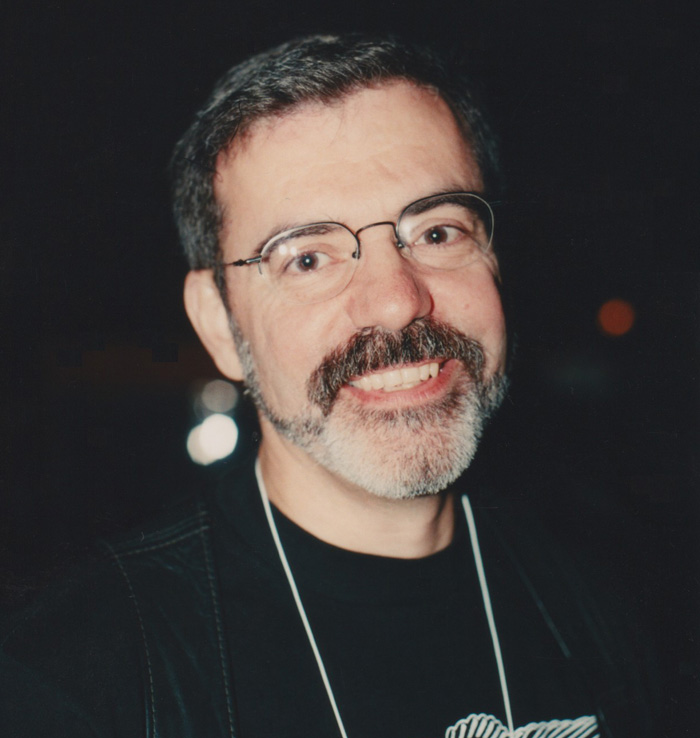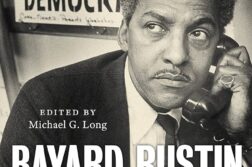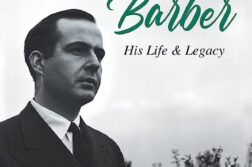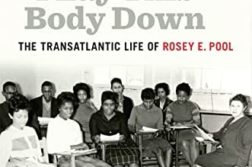THE OBITUARY OF ALLAN BÉRUBÉ that appeared in The New York Times began with a reference to his MacArthur Fellowship and then moved on to Coming Out Under Fire (1990), his groundbreaking history of gay men and lesbians during World War II. Such obvious attention to these two markers as the signal achievements of his life is understandable. The MacArthur award labeled Allan a “genius,” and a book about World War II planted him squarely in the mainstream of American history. As a topic, it is readily legible to almost everyone as “important.”
I think of Allan differently. “Public intellectual” is a contemporary phrase that perhaps comes closer to capturing who he was and what he did, but even that distorts my picture of him. Public intellectual conjures images of tenured academics of high repute—my former dean, Stanley Fish, pops to mind—who, besides composing their scholarly studies, also publish op-eds in the Times and The Washington Post or essays in The New Republic. Or, these days, they blog and are quoted by other bloggers. That still isn’t Allan.
Allan was a community historian. He believed passionately in the power of history to change the way individuals and even whole groups of people understood the world and their place in it. Except for short interludes, such as the year he held a Rockefeller Fellowship at the Center for Lesbian and Gay Studies in New York, he was always without formal—and paid—connections to the institutions that sustain intellectual and cultural work. He reported, so to speak, to the people whose history he wrote about. He most cared about how community members—LGBT folks—responded to his talks and his writings, not in the sense of craving their approval, but more as evidence that the history he uncovered was having an impact.
Allan’s death has made me think about the state of GLBT community history. Much has changed in the decades since he and a random collection of folks scattered across the country began digging into a queer past. Some of that change has been for the better, some perhaps not. By most measures, there is more queer history circulating in the public sphere than ever before. But one could also argue that this history is more detached than ever before from the community it describes.
I first met Allan in the spring of 1979. I had come to San Francisco from New York for a stay of several months to research a history of the pre-Stonewall movement. My best friend, Estelle Freedman, a faculty member at Stanford who was a pioneer in the field of women’s history, had just gotten to know Allan through meetings of the recently formed San Francisco Lesbian and Gay History Project. She plotted an early introduction of the two of us, suspecting as only best friends can that he and I would hit it off. We did. My calendar for that year has “Allan B” marked across Saturday May 12th. That day, we began a conversation that, by one measure, lasted well into the night, but in another sense continued for decades.
That spring, queer  San Francisco was experiencing a tumultuous moment in its own history. In 1978, California had faced a statewide ballot initiative, Proposition Six, that would have prohibited the employment in the schools of gay men and lesbians. San Francisco activists played a key part in the successful mobilization against it. Soon after its rejection at the polls, Harvey Milk, the first openly gay supervisor in San Francisco and a leader in the anti-Prop-Six campaign, was assassinated by Dan White, a conservative former supervisor. The trial of Dan White for murder was just concluding when Allan and I met. The queer rioting at City Hall that followed the verdict—the stunning spectacle of a row of burning police cars set on fire is its central image—remains the backdrop to this period of time when, as I experienced it, a gay, lesbian, and transgender community history began to flower.
San Francisco was experiencing a tumultuous moment in its own history. In 1978, California had faced a statewide ballot initiative, Proposition Six, that would have prohibited the employment in the schools of gay men and lesbians. San Francisco activists played a key part in the successful mobilization against it. Soon after its rejection at the polls, Harvey Milk, the first openly gay supervisor in San Francisco and a leader in the anti-Prop-Six campaign, was assassinated by Dan White, a conservative former supervisor. The trial of Dan White for murder was just concluding when Allan and I met. The queer rioting at City Hall that followed the verdict—the stunning spectacle of a row of burning police cars set on fire is its central image—remains the backdrop to this period of time when, as I experienced it, a gay, lesbian, and transgender community history began to flower.
The publication, in 1976, of Jonathan Ned Katz’s Gay American History had launched Allan’s own explorations. Allan, a college dropout, took inspiration from the fact that Katz, another college dropout, produced such a magnificent piece of historical research. So, in the hours when he was not working as an assistant manager of a neighborhood movie theater, Allan reeled through newspaper microfilms at the San Francisco Public Library and snooped through archival collections across the Bay at Berkeley’s Bancroft Library. By the time I met him, he had accumulated quite a trove of material.
He was also, by 1979, not working alone. Allan and several others, almost all without academic affiliations, had recently formed the San Francisco Lesbian and Gay History Project. I’m not sure whether this was the first such group in the U.S., but it certainly brought together a set of impressive intellects. Besides Allan, there was Jeff Escoffier, Estelle Freedman, Eric Garber, Amber Hollibaugh, and Gayle Rubin; today, their collected works would make for a busy season of reading. That summer, the History Project went public with two remarkable events: Allan’s “Lesbian Masquerade,” an illustrated talk about women who passed as men in 19th-century San Francisco; and “Spontaneous Combustion,” a panel that provided a historical dimension to police harassment of queers in San Francisco.
Katz’s Gay American History had a section called “Passing Women” that provided documentary accounts of female-bodied individuals who lived and moved in the world as men. In working his way through 19th-century newspapers, Allan had found a substantial number of such stories, including a few that were so detailed that he could almost reconstruct a short biography with pictures. Allan premiered “Lesbian Masquerade” at the Women’s Building during Pride Month, before a crowd of several hundred. The thirst for history was so great that a man presenting this material in the days when separatism was still powerful produced barely a ripple in the audience; nor was there controversy about his labeling this history as lesbian. Instead, Allan’s ability to project queer life more than a hundred years back in time produced laughter, applause, tears, and a thrill that coursed through the crowd.
A few weeks later, in early August, the History Project convened a panel, “Spontaneous Combustion,” that included me, Jeff, Amber, and Lois Helmbold, a teacher at San Jose State. Again, the hall was packed. Various incidents in the weeks since the City Hall rioting had added fuel to police-community tensions, and the audience was seething with anger. At this distance in time, I can’t remember what the others talked about. But I know that I spoke about the late 1950’s and early 1960’s when sustained police attacks upon queer bars provoked rebellion within the bar world. As I put it then, the movement and the subculture converged in San Francisco in those years, and that convergence helped produce a pre-Stonewall movement more elaborate and powerful than anywhere else.
I remember that my argument, which seems so obvious to me now, was as much a product of witnessing contemporary events as it was of pulling some inherent meaning out of the historical record. That is, having seen how gay men poured out of the bars on Castro Street the night of the Dan White verdict, marched to City Hall, and set those police cars aflame, I was more easily able to attach a significance to an earlier bar rebellion that had erupted spontaneously from beyond the boundaries of a much tamer homophile movement. And, just as witnessing contemporary events allowed me to see the past differently, a historical interpretation of the bars as a resource for political mobilization had contemporary implications as well. Many gay liberationists and lesbian feminists evinced intense hostility toward the bar world; they saw bar patrons and the bars themselves as an obstacle to political consciousness. Here was an example of how past and present might speak to each other, how researching history and offering it to a community audience could create productive dialogue and debate that, in turn, might shape tomorrow’s activism.
Meanwhile, as Allan continued to show “Lesbian Masquerade” in the Bay Area, his visibility as a local historian brought an unexpected reward. A friend of a friend told Allan that, for several years, a neighbor had been saving a cache of correspondence he had found when he moved into his current apartment. The letters had apparently belonged to the previous resident, Harold Clark, now deceased, and they chronicled the friendship and experiences of a group of gay men who had met while serving in the military during World War II. Allan was beside himself; his correspondence overflowed with excitement. In these pre-fax, pre-scanning days, he filled his handwritten letters to me with long extracts from those of Clark and his wartime buddies. The materials launched Allan on the 10-year project that became Coming Out Under Fire and that, along the way, generated even more grassroots historical work. He put together a new slide talk on World War II and, as he traveled with it around the country, veterans flocked to see the show and then made themselves available for interviews, thus adding their voices to the historical record. I can’t prove the connection, but I have a strong hunch that the organizing among veterans that exploded into the open during the gays-in-the-military debate of 1993 had something to do with the way that Allan embedded his historical work in community organizations and in networks of older gay men and lesbians.
I’m emphasizing Allan in this telling of how a community-based history emerged at the end of the 1970’s, because he was central to how I experienced it. But, really, this tale could be relayed through the work of any number of folks. By the early 1980’s, the history slide talk presented to a community audience had become something of a rage. I saw Jim Steakley mesmerize an audience of several hundred in New York with a presentation, almost two hours long, about the German gay movement in the early 20th century. Judith Schwarz entertained folks with an account of a pre-Depression-era world of bohemian women in Greenwich Village. Members of the Boston History Project crafted a lecture with slides that stretched from Puritan New England in the 17th century to the mid-20th century. Roberta Yusba, a San Francisco history project member who had become fascinated with the lesbian pulp novels of the 1950’s and 60’s, assembled a slide talk filled with images of the cover art that was not only informative but also often elicited gales of laughter. About this time, too, Greg Sprague, a graduate student at Loyola University, began researching Chicago’s GLBT past. He scoured newspapers, found documents, and put together a slide show that helped bring folks out of the closet who, in turn, became available to be interviewed by him. Sprague’s work morphed into a local history project that still, a generation later, lives on in Chicago in the form of the Gerber/Hart Library’s rich repository of books, newspapers, and archival collections.
I also remember well the traveling history presentation put together by the women of the Lesbian Herstory Archives (LHA) in New York, one that I saw Joan Nestle deliver a few times in different cities, at a point when her speaking gigs and mine seemed to overlap quite a bit. The LHA rightly prides itself on its identity as a collective, and I don’t mean to single out Joan here. Still, anyone who has encountered her over the years knows that “charisma” barely does justice to the impression she leaves with audiences. Her presentations around the country inspired lots of lesbians to see their own lives and the lives of other women in their communities as having historical significance. Letters, photos, diaries, scrapbooks, and other memorabilia have been saved from the dump because of the work of the Herstory Archives.
The folks I’ve mentioned saw themselves as primarily engaged in a project of historical reconstruction, but there were other community-based intellectuals working in the 80’s who drew upon history as well. Michael Bronski, Jeff Escoffier, Essex Hemphill, Amber Hollibaugh, Mab Segrest, and Barbara Smith all come to mind: activist intellectuals—or maybe intellectual activists—who incorporated history into their cultural and political work and addressed their work directly to the community about whom they wrote.
As various slide talks traveled around the country and fed, intellectually and emotionally, not just their audiences, but the individuals who produced them, community-based historians also drew sustenance from an activist community press that was hungry for material and had not yet morphed into heavily commercialized enterprises. Toronto’s Body Politic, for instance, published a multiple-part series by Jim Steakley on the German movement and by me on the radical origins of the Mattachine Society. Gay Community News out of Boston, Lavender Woman from Chicago, and Gay Sunshine in the Bay Area, all papers that reached beyond their place of publication, carried writing about history. Marie Kuda, a community historian in Chicago, could count on the local queer papers to publish her work. Even The Advocate which, under David Goodstein, was moving rapidly in the direction of a corporate model, snatched up long pieces by Bérubé and Sprague. In what I refer to as the “long” post-Stonewall decade, there was a hunger for history and, to the degree it was satisfied, nourishment came from researchers and writers who presented their work in community contexts.
What happened to this kind of community-grounded historical work? Where did it go? Like so much else from that long post-Stonewall era, I think of it as having been swamped by and buried under the period of upheaval that stretched roughly from the March on Washington and the birth of ACT UP in 1987 to the Stonewall 25 commemorations in 1994. Someday, a smart historian will need to chart and explain the depth (and limits) of the change during those years. It far surpasses anything associated with Stonewall and, in many respects, the legacy seems both more complex and more ambiguous to me.
Take, for example, what happened to the practice of GLBT history. I’ve just painted a fairly rosy picture of the work of community historians in the late 1970’s and 1980’s. In terms of the satisfaction and thrill that the work brought to both the practitioners and the audiences, it was glorious. But it was also a tale of struggle, like so much of gay and lesbian life still was in those post-Stonewall years. It was a story of working with few resources, of doing the work part-time in between the jobs that paid the rent, of lacking institutional roots and stability. There were still very few published books on queer history. People were dependent on the traveling historians, burdened under the weight of slide trays and projector, or on the happenstance of stumbling upon the articles that appeared unpredictably in a press whose circulation was not very wide.
By the mid-1990’s, one could point to a host of indicators that signaled a change in how knowledge about GLBT people got produced. A series of large, dynamic queer studies conferences had taken place at major elite universities. Queer theory became for a time the academic rage. In the wake of the new visibility provoked by AIDS militancy and the gays-in-the-military debate, the mainstream press and the academy embraced new books like George Chauncey’s 1994 landmark study Gay New York, thus giving gay history an unprecedented legitimacy. More archives and historical societies began to collect and preserve our materials. More dissertations started to flow out of the academy. More of us had tenure-track jobs. To make the change personal: I still wake up in the morning and can’t believe that the state of Illinois is paying me well to teach gay and lesbian history classes. I laugh with delight at the wonderful things that happen, with great regularity, in the course that I think of as “Gay 101.”
This is all to the good. I do not want to turn back the clock. But something got lost along the way, and Allan’s death has jolted me into noticing it. Teaching a group of undergraduates is worthwhile work, but they scatter in forty different directions at the end of each semester rather than encountering each other with regularity through a network of organizations, institutions, and businesses that sustain a collective identity. Writing academic history that will get one tenured is worthwhile work. It seeps into the professional literature and, slowly (oh, so slowly), works a change in the content of historical narratives. But academic history is written differently than community history. It has to pass muster with a different audience; it has to frame its concerns in ways that speak to the professional literature; it has to impress an audience of peers with its mastery of a scholarly apparatus. It is not, for the most part, readily accessible to a community audience.
In Chicago over the last few years, the Center on Halsted (a GLBT community-based organization) and the Chicago History Museum (formerly the Chicago Historical Society) have partnered to present a series called “Out at CHM.” Three times a year, the museum hosts an evening of queer history programming. Last spring, I coordinated and emceed an evening called “Gay Is the Revolution.” As preparation, over a period of a few months, I worked with a few Chicago activists from the Stonewall era, interviewing them collectively and separately, drawing out the themes in their experiences, and helping shape their memories into a cohesive program. I offered a historian’s take on the era, and they each presented, vividly and passionately, their reflections on what they had lived through and accomplished a generation earlier. The large auditorium was packed to overflowing; people hung on every word. Two hours passed, and still no one wanted to leave. If we could have stayed longer, if there were continuing venues available for the kind of discussion that was ready to bubble up from that audience, who knows what sort of conversations about politics, values, visions, and other matters of great consequence might ripple outward?
The evening reminded me of the slide talks of Allan and others a generation ago. I felt again, palpably, the hunger for history as a resource for self-affirmation as well as its power as a tool for constructing community. And I felt saddened that the resources for a community-based history and community-based historians have not grown at a rate commensurate with how the institutions of the LGBT community have grown in the last quarter century. Some of the community-based history organizations that formed a generation ago still exist, but none of them comes anywhere near to having the resources of money, space, and staff that each could productively use.
George Orwell once wrote something to the effect that whoever controls the past commands the future. I don’t know if he was right. But, just in case he was, I’d like to know that the many queer histories needing to be written and told would rise up from, and out of, our own queer communities.
John D’Emilio’s books include Sexual Politics, Sexual Communities; Lost Prophet: The Life and Times of Bayard Rustin; and Intimate Matters.






